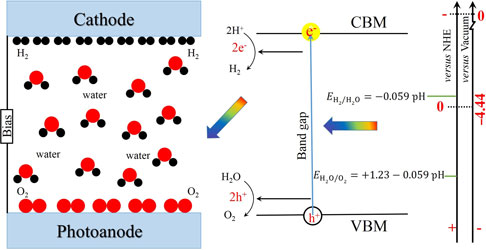Crossref Citations
This article has been cited by the following publications. This list is generated based on data provided by
Crossref.
Ye, Yifan
Thorne, James E.
Wu, Cheng Hao
Liu, Yi-Sheng
Du, Chun
Jang, Ji-Wook
Liu, Erik
Wang, Dunwei
and
Guo, Jinghua
2018.
Strong O 2p–Fe 3d Hybridization Observed in Solution-Grown Hematite Films by Soft X-ray Spectroscopies.
The Journal of Physical Chemistry B,
Vol. 122,
Issue. 2,
p.
927.
Feng, Ji
Yang, Fan
Ye, Yifan
Wang, Wenshou
Yao, Xiaxi
Fan, Qingsong
Liu, Luntao
Aleisa, Rashed M.
Guo, Jinghua
and
Yin, Yadong
2019.
Surface-bound sacrificial electron donors in promoting photocatalytic reduction on titania nanocrystals.
Nanoscale,
Vol. 11,
Issue. 41,
p.
19512.
Ye, Yifan
Song, Min-Kyu
Xu, Yan
Nie, Kaiqi
Liu, Yi-sheng
Feng, Jun
Sun, Xuhui
Cairns, Elton J.
Zhang, Yuegang
and
Guo, Jinghua
2019.
Lithium nitrate: A double-edged sword in the rechargeable lithium-sulfur cell.
Energy Storage Materials,
Vol. 16,
Issue. ,
p.
498.
Frati, Federica
Hunault, Myrtille O. J. Y.
and
de Groot, Frank M. F.
2020.
Oxygen K-edge X-ray Absorption Spectra.
Chemical Reviews,
Vol. 120,
Issue. 9,
p.
4056.
Xie, Fangxi
Zhang, Lei
Jiao, Yan
Vasileff, Anthony
Chao, Dongliang
and
Qiao, Shi-Zhang
2020.
Hydrogenated dual-shell sodium titanate cubes for sodium-ion batteries with optimized ion transportation.
Journal of Materials Chemistry A,
Vol. 8,
Issue. 31,
p.
15829.
Alvarado, Judith
Barim, Gözde
Quilty, Calvin D.
Yi, Eongyu
Takeuchi, Kenneth J.
Takeuchi, Esther S.
Marschilok, Amy C.
and
Doeff, Marca M.
2020.
Optimization of nonatitanate electrodes for sodium-ion batteries.
Journal of Materials Chemistry A,
Vol. 8,
Issue. 38,
p.
19917.
Stanescu, Dana
Piriyev, Mekan
Villard, Victoria
Mocuta, Cristian
Besson, Adrien
Ihiawakrim, Dris
Ersen, Ovidiu
Leroy, Jocelyne
Chiuzbaian, Sorin G.
Hitchcock, Adam P.
and
Stanescu, Stefan
2020.
Characterizing surface states in hematite nanorod photoanodes, both beneficial and detrimental to solar water splitting efficiency.
Journal of Materials Chemistry A,
Vol. 8,
Issue. 39,
p.
20513.
Martin Guaregua, Nancy
Viniegra, Margarita
Vargas, Rubicelia
and
Garza, Jorge
2020.
Óxidos nanoestructurados de metales de transición con aplicaciones en catálsisis.
Mundo Nano. Revista Interdisciplinaria en Nanociencias y Nanotecnología,
Vol. 14,
Issue. 26,
p.
1e.
Ravi, S.
and
Winfred Shashikanth, F.
2020.
Magnetic properties of Mo-doped TiO2 nanoparticles: A candidate for dilute magnetic semiconductors.
Materials Letters,
Vol. 264,
Issue. ,
p.
127331.
Liu, Chang
Qian, Jin
Ye, Yifan
Zhou, Hua
Sun, Cheng-Jun
Sheehan, Colton
Zhang, Zhiyong
Wan, Gang
Liu, Yi-Sheng
Guo, Jinghua
Li, Shuang
Shin, Hyeyoung
Hwang, Sooyeon
Gunnoe, T. Brent
Goddard, William A.
and
Zhang, Sen
2020.
Oxygen evolution reaction over catalytic single-site Co in a well-defined brookite TiO2 nanorod surface.
Nature Catalysis,
Vol. 4,
Issue. 1,
p.
36.
Chen, Dongchang
Ahn, Juhyeon
Self, Ethan
Nanda, Jagjit
and
Chen, Guoying
2021.
Understanding cation-disordered rocksalt oxyfluoride cathodes.
Journal of Materials Chemistry A,
Vol. 9,
Issue. 12,
p.
7826.
Wongpanya, Pornwasa
Pintitraratibodee, Nattapol
Thumanu, Kanjana
and
Euaruksakul, Chanan
2021.
Improvement of corrosion resistance and biocompatibility of 316L stainless steel for joint replacement application by Ti-doped and Ti-interlayered DLC films.
Surface and Coatings Technology,
Vol. 425,
Issue. ,
p.
127734.
Wongpanya, Pornwasa
Wongpinij, Thipusa
Photongkam, Pat
and
Siritapetawee, Jaruwan
2022.
Improvement in corrosion resistance of 316L stainless steel in simulated body fluid mixed with antiplatelet drugs by coating with Ti-doped DLC films for application in biomaterials.
Corrosion Science,
Vol. 208,
Issue. ,
p.
110611.
Shi, Zhaoping
Li, Ji
Jiang, Jiadong
Wang, Yibo
Wang, Xian
Li, Yang
Yang, Liting
Chu, Yuyi
Bai, Jingsen
Yang, Jiahao
Ni, Jing
Wang, Ying
Zhang, Lijuan
Jiang, Zheng
Liu, Changpeng
Ge, Junjie
and
Xing, Wei
2022.
Enhanced Acidic Water Oxidation by Dynamic Migration of Oxygen Species at the Ir/Nb2O5−x Catalyst/Support Interfaces.
Angewandte Chemie,
Vol. 134,
Issue. 52,
Shi, Zhaoping
Li, Ji
Jiang, Jiadong
Wang, Yibo
Wang, Xian
Li, Yang
Yang, Liting
Chu, Yuyi
Bai, Jingsen
Yang, Jiahao
Ni, Jing
Wang, Ying
Zhang, Lijuan
Jiang, Zheng
Liu, Changpeng
Ge, Junjie
and
Xing, Wei
2022.
Enhanced Acidic Water Oxidation by Dynamic Migration of Oxygen Species at the Ir/Nb2O5−x Catalyst/Support Interfaces.
Angewandte Chemie International Edition,
Vol. 61,
Issue. 52,
Barim, Gözde
Dhall, Rohan
Arca, Elisabetta
Kuykendall, Tevye R.
Yin, Wei
Takeuchi, Kenneth J.
Takeuchi, Esther S.
Marschilok, Amy C.
and
Doeff, Marca M.
2022.
Heterostructured Lepidocrocite Titanate-Carbon Nanosheets for Electrochemical Applications.
ACS Applied Nano Materials,
Vol. 5,
Issue. 1,
p.
678.
Wei, Yanze
Zhao, Decai
Wan, Jiawei
and
Wang, Dan
2022.
Electron–orbital–lattice interactions in hollow multishelled structures.
Trends in Chemistry,
Vol. 4,
Issue. 11,
p.
1021.
Wongpanya, Pornwasa
Silawong, Praphaphon
and
Photongkam, Pat
2022.
Adhesion and corrosion of Al–N doped diamond-like carbon films synthesized by filtered cathodic vacuum arc deposition.
Ceramics International,
Vol. 48,
Issue. 14,
p.
20743.
Zhu, Lin
Ma, Chenglong
Zhang, Yiheng
Shao, Xiang
Cao, Limei
and
Yang, Ji
2023.
Bench-scale processing of TiBOx/h-BN ceramics for alkaline water splitting applications.
Ceramics International,
Vol. 49,
Issue. 17,
p.
28434.
Shi, Zhaoping
Li, Ji
Wang, Yibo
Liu, Shiwei
Zhu, Jianbing
Yang, Jiahao
Wang, Xian
Ni, Jing
Jiang, Zheng
Zhang, Lijuan
Wang, Ying
Liu, Changpeng
Xing, Wei
and
Ge, Junjie
2023.
Customized reaction route for ruthenium oxide towards stabilized water oxidation in high-performance PEM electrolyzers.
Nature Communications,
Vol. 14,
Issue. 1,
